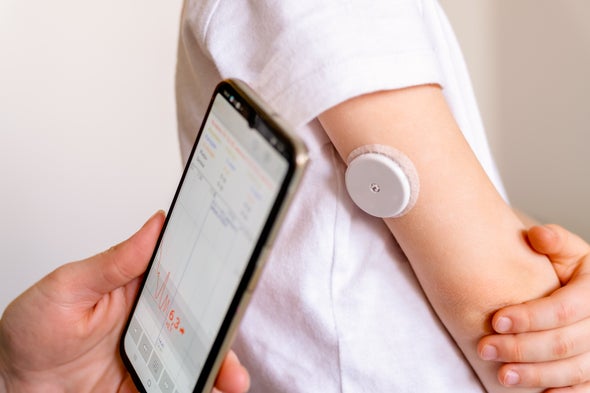We were on a summer vacation in 2020 when I first noticed signs of my son’s chronic illness. At a lake house, my then 11-year-old appeared thinner than usual and was eating quite a bit of candy (even for vacation mode). And then I realized he was getting up several times a night to pee, a sign of type 1 diabetes. In that condition, when the level of glucose in your blood gets too high—because the immune system is killing off cells that normally make the insulin that shuttles sugar out of the bloodstream and into your cells—the body tries to flush it out to prevent toxicity. And without sugar to feed your cells, the body works hard to get that energy—in my son’s case, through mouthfuls of candy.
A pediatric medical appointment, where the doctors were initially confident my son didn’t have the disease, confirmed a sky-high blood-glucose reading above 300 milligrams per deciliter (mg/dL) and an A1C (a measure of blood sugar over the previous three or so months) that was well above the “normal” range. He had type 1 diabetes.
I pictured the parent-child relationship transforming into more of a nurse-patient one, where I’d become a pro at insulin shots, insulin-to-carbohydrate calculations and all things related to my son’s daily and nightly needs. I was wrong. Advances in technology have meant that his diabetes is much more manageable, and we can all get a good night’s sleep.
At the beginning of our diabetes journey, my husband and I set our alarms for almost every hour to make sure my son’s sugar levels didn’t get too low or high. Soon after leaving the hospital, my son started wearing a continuous glucose monitor (CGM) that we could scan with a phone app to view his levels. So instead of needing to do a finger prick for blood glucose checks every two to three hours, I could swipe my phone across the silver-dollar-size device sticking to his arm. Even so, we still needed to give individual shots every time he ate and if his insulin went above 120 mg/dL or so. In the middle of the night, that is a tricky endeavor.
This treatment was a huge advancement from decades ago: When current Supreme Court justice Sonia Sotomayor was diagnosed in the 1960s, she had to use a razor to draw blood for testing. And with no disposable needles, she had to boil water to sterilize her insulin shots.
Once we added an insulin pump to my son’s care, life got even better. No more shots. Instead we stick an Omnipod pump—which is the size of a pack of dental floss and has no tubes or wires—to his belly or leg and program it with a phonelike device. Most recently, we switched to the Omnipod 5 system, an insulin pump that communicates with his CGM (now the Dexcom G6 system) and learns his body’s insulin needs over time. We change his pump every three days, and each time, the algorithms get smarter: when his sugars go up, before we even intervene to give him a “correction,” the Omnipod device delivers more insulin at a certain rate to keep his blood sugar in a certain range. This last bit of smart technology, released this past August, has meant I don’t even set my once-a-night alarm to check for highs (we now have a loud alarm for lows on our phones); the Omnipod 5 does the corrections for us.
And while things aren’t perfect, and my son’s numbers still go high when the insulin pump can’t keep up with a rapid sugar increase, I know that the pump is “working on it.” I also know that the next “Pod” change will mean even better results. Sleeping through the night has been incredible for my physical and mental health.
Right now my son can never forget that he has diabetes because eating without a “bolus” (a dose of insulin) or exercising when his sugars are low could send him to the hospital. But with further advances in diabetes-management technology, his chronic disease could occupy even less of our attention.
This technology also supports something my son told me during the first few months of his diagnosis: He is not “a diabetic.” He is a person who “has diabetes.”

